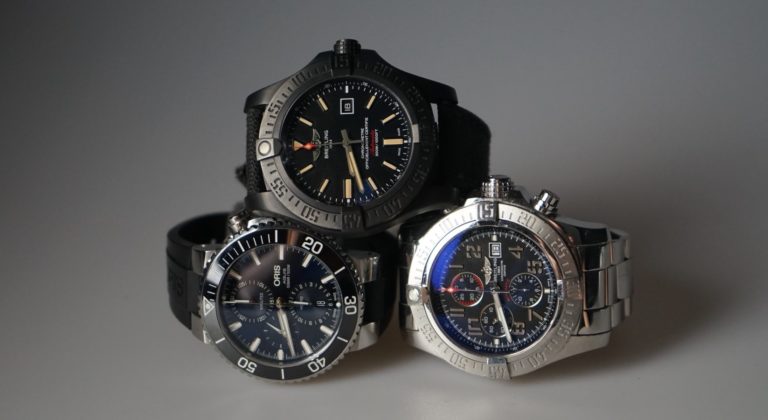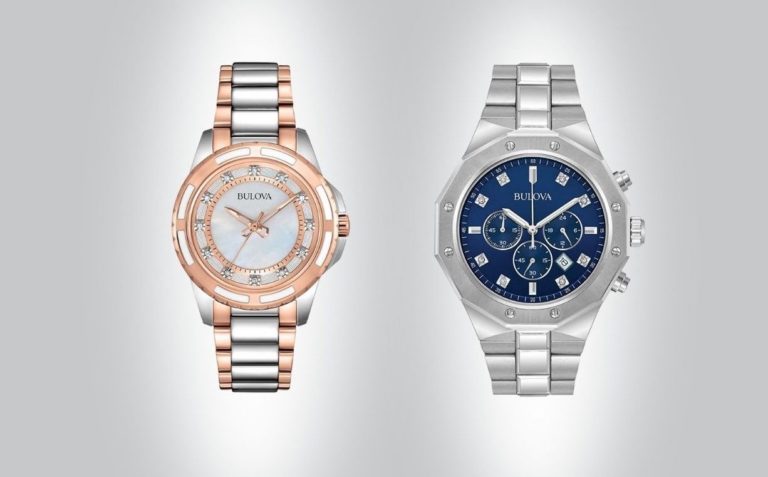Affiliate Disclosure: As an Amazon Associate I earn from qualifying purchases. Details
People always strive towards the convenience of use regarding various technological gadgets, and wristwatches are no exception. Out of all of the various types of wristwear, solar atomic watches provide the convenience that no other can offer.
The following guide uncovers the core of these watches in how they function, what they offer, and who they suit.
We’ll also bring out the top timepieces to look out for when searching for a carefree timepiece.
Therefore, stay with us in discovering the most carefree watch ever created.

What Is a Solar Atomic Watch?
First of all, what exactly is a solar atomic watch?
A solar atomic watch is a timepiece that receives power from light and is accurate to atomic precision.
It means that you can entirely forget the concerns over the accuracy your watch provides because there isn’t any more precise type of watch available. It doesn’t lose even a second a year!
In addition, you don’t have to worry about the watch running out of charge or wasting time and money on replacing the batteries because solar atomic watches employ rechargeable cells that charge from any light over and over again. It means that it charges itself whenever the watch is presented to light.
Therefore, in a nutshell, you’ll get an entirely hassle-free timepiece that doesn’t require any time adjustments or battery replacements.
Now, if you have already started to wonder about the astronomical prices you would have to pay for such an intricate watch, rest assured because the prices are reasonable – a quality solar atomic watch costs around $300-$500.
Solar & Atomic Technologies
The two technologies behind these watches are solar-powered movement and atomic timekeeping.
Let’s have a closer look at the technologies and how they work.
Solar Power
Solar power is quite a new advancement in the industry. Although the first solar-powered timepieces emerged already in the 1970s, the trend gained popularity several decades later.
What makes solar technology so special is the recharging possibility from not only sunlight but from all sorts of light. If a typical battery runs out of energy upon consumption, the rechargeable cell is capable of receiving and storing it, in that providing a constant charge.
Although the chances that a solar-powered watch runs out of energy are limited, the timepiece is not entirely maintenance-free, with the rechargeable cell needing a replacement after about 15-40 years.
However, compared to a quartz watch that requires battery replacements every 2-3 years, the 15-40 years is simply magnificent.
But how does a solar-powered watch work?
A solar watch has a panel behind the crystal that absorbs sunlight and other sorts of lights. The panel then converts the light into electrical energy, which eventually powers the quartz mechanism.
The unused power is stored in a rechargeable cell, and during the night or when covered, the watch uses that energy.

Feel free to read our ultimate guide to solar watches for more information about the various technologies.
Atomic Timekeeping
The second ingredient in solar atomic watches is atomic timekeeping. What the technology does is that it adjusts the time via radio waves from an atomic clock.
The timekeeping is so flawless that the watch will lose or gain only a fraction of a second in thousands of years, meaning it will never lose time.
The base timekeeping of the watches is conducted by a quartz movement, which means the adjustments are made to that movement type.
There are around 400 atomic clock towers worldwide, contributing to the calculation of international atomic time. Therefore, the vast majority of territories in the world are covered with these towers.
In the USA, for example, atomic time is distributed from NIST-F1, which is located in Boulder, Colorado.
Now, you may wonder how and when the adjustments to time are made.
The atomic clock adjusts the time through low-frequency radio signals on several occasions at night. A miniature receiver searches the signal and decodes it for an update.

The calibration occurs at night because signal interferences from other sources, such as metals and radio waves, are much lower than during the day.
A typical reach of waves from a transmitter covers up to 2,000 miles, so if a wristwatch is out of the range for an extended period, the watch runs as usual but won’t receive any time calibration. When back in the area, the watch will make adjustments.
Pros of Solar Atomic Watches
A solar atomic watch is the epitome of convenience, offering incomparable advantages over the other types of wristwear. The most notable of them are listed below.
1. Maintenance-Free
To a large extent, the wristwear is maintenance-free.
When mechanical watches need cleaning and balancing and quartz watches require constant power source replacements, solar atomic watches are free of such matters.
They don’t require regular upkeep from a watchmaker nor any systematic power source substitution.
2. Always Accurate
Since the timekeeping relies on already sufficiently accurate quartz movement, which is furthermore adjusted to atomic precision through radio waves, the outcome is a marvel.
When you think that an atomic watch loses one second in 100 million years, further words are unnecessary.
3. Hassle-Free
Forget manual time adjustments or any concerns about the watch stopping at one point due to the loss of energy – the technologies employed in the watches have eliminated the inconveniences, providing a hassle-free user experience.
4. Guaranteed Quality
The number of brands providing solar atomic watches is limited to a couple of manufacturers.
However, the few producing them are all renowned for the quality they’ve provided throughout history. Therefore, besides the convenience that comes with these watches, you can also expect genuine durability.

Cons of Solar Atomic Watches
Despite the overwhelming advantages, solar atomic watches still have some cons.
1. Distance From the Atomic Clock
One of the disadvantages is the distance from the atomic clock. Although the Fort Collins clock’s broadcast reach in the USA is about 2,000 miles, in that covering the majority of states, it still won’t reach Hawaii and Alaska.
The same problem occurs in several places in the world. For instance, atomic timekeeping isn’t available in South America, Oceania (Australia, New Zealand), and Africa.
Therefore, if you live outside the broadcast reach, you won’t benefit from atomic timekeeping, leaving you with only solar power.
2. In Need of Constant Light
Another requirement for the watch to function is the presence of light. While most wearers carry their watches on their wrists, which is sufficient for the cell to charge, some people keep their watches in low-light conditions for an extended period.
Hence, the charging may not be adequate, and the watch with multiple features consuming energy may run empty.
However, the chance for this to happen is considerably low, especially given the minimum power reserve of six months of most watches.
GPS-Controlled Watches
Radio-controlled watches have been around for a couple of decades, which means they’re not the latest hits in horology. During that time, more advanced atomic-precision timepieces have emerged – GPS-controlled watches.
The working principle of these analog watches is very similar to atomic watches, but instead of radio waves, they use satellite signals for time adjustments.

With this feature, the watch is no longer dependent on the distance from the atomic clock. Thus, GPS-controlled solar watches eliminate one of the setbacks in dealing with atomic wristwear – the range.
The providers of GPS-enabled watches are actually the same brands that offer terrestrial atomic wristwear – Seiko and Citizen. However, the prices of such timepieces are much higher, often exceeding the $1,000 mark.
Solar Atomic Watches
The pool of solar atomic wristwatches isn’t too big, yet the reliability of the brands and their time-trackers is high. Solar and atomic technologies aren’t easy to develop. Moreover, providing a consistent quality year after year is even more difficult.
Therefore, the three Japanese brands – Citizen, Casio, and Seiko – have really proved their status to be the best in pioneering innovations.
And as we can witness from the following paragraphs, their watches are truly one-of-a-kind examples of innovativeness.
Following, you’ll find the most notable watches from Citizen, Seiko, and Casio.
Citizen
Citizen is the pioneer in multi-band radio-controlled watches when the first-ever wristwatch with that feature appeared in 1993. However, its first light-powered analog quartz watch was introduced already as early as 1976.
The collections combining both solar and atomic technologies are Promaster Skyhawk A-T, World Chronograph A-T, World Perpetual A-T, and PCAT.
Citizen Eco-Drive World Chrono
Model: AT8113-04H
Case Size: 43mm
Crystal: Sapphire
Power Reserve: 6 months
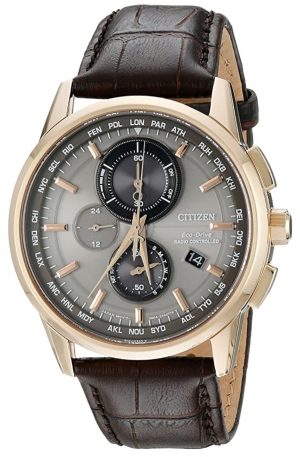
The Citizen World Chrono AT8113-04H is a perfect companion for frequent travelers who prefer their timepieces to be on the dressier side rather than casual.
It has an analog dial where the hands adjust to atomic precision, no matter the timezone you’re situated. The dark-toned face is also equipped with several subdials displaying a 1/20-second stopwatch, 24-hour time format, World Time feature, power reserve indicator, and perpetual calendar.
Therefore, the watch has fitted several appreciated functions that all find good use in everyday life.
What makes the watch even better is that it is perfectly sized at 43mm, suiting various wrist sizes and shapes. The stainless steel case’s copper-ish tone and the brown leather strap are also something that provides appropriateness for various occasions.
On top of the excellent functionality and appearance, this Citizen watch is protected with a high-quality sapphire crystal and is guaranteed a 100m (330ft) water resistance.
And let’s not forget the watch is solar-powered, with a 6-month power reserve once fully charged.
The only thing to pick about with this Citizen World Chrono is its somewhat poor legibility due to the low contrast between the background and the hands. Other than that, it’s a top-quality solar atomic watch for the money.
Citizen World Chronograph A-T “Blue Angels”
Model: AT8020-03L
Case Size: 43mm
Crystal: Sapphire
Power Reserve: 6 months
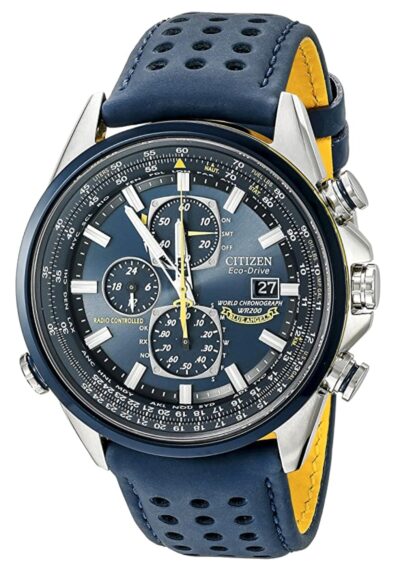
Some of the best-selling watches from the Citizen brand are definitely aviation watches. And if there’s one type of watch where the accuracy and convenience of a solar atomic watch are essential, it is precisely an aviation watch.
The Citizen A-T “Blue Angels” has been one of the fans’ favorite for years, mainly due to the combination of an attractive appearance and high practicality.
If you wondered what the Blue Angels is, then it’s a flight demonstration squadron in the ranks of the US Navy. Both of the dominating colors from the jets, blue and yellow, are represented on this Citizen watch.
On top of the appealing color scheme, you’ll find a relevant function in pilot watches – a slide rule bezel. Sitting on the dial’s outer ring, the feature helps calculate various measurements a pilot might need during the flight.
Also, you won’t be missing out on other practical functions, such as the 1/20-second chronograph and perpetual calendar.
When it comes to atomic timekeeping, it is available in 26 time zones. It means that if you travel, you have to set the correct time zone to show you the local time.
Citizen PCAT CB5908-57E
Model: CC3039-08E
Case Size: 42mm
Crystal: Sapphire
Power Reserve: 6 months

The Citizen PCAT watch is one of the best timepieces from the brand. It combines solar power and atomic timekeeping with a highly appreciated titanium construction and several coveted functions. There are only a few watches in the world that offer that much for the money.
On top of that, the PCAT looks absolutely stunning. It has masculine apparel with a dark dial and metal construction. The dial looks busy but is not overly busy, featuring subdials for the perpetual calendar, stopwatch, and 24-hour time.
In terms of size, the watch measures a modest 42mm in diameter. Therefore, most men will find the size appropriate as it is neither large nor small. It sits on the wrist comfortably due to the slightly curved lugs. Moreover, the watch is much lighter than most metal watches, weighing 4 oz (110 g).
The most significant concern with this watch is the complicated setup and switching between the various features. Fortunately, Citizen has comprehensive guides available for every model, which you can find here.
Citizen Satellite Wave GPS
Model: CC3039-08E
Case Size: 44mm
Crystal: Curved mineral
Power Reserve: 6 months
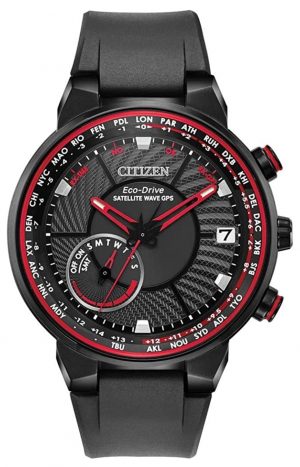
Technologically, one of the top solar atomic watches you can get is the Citizen Satellite Wave GPS watch. Fitted with the Satellite Wave innovation, the wearable makes time corrections through satellite signals while maintaining the possibility of radio synchronizations as well.
Besides the unique and high-class technology, the Citizen timepiece strikes with posh aesthetics that won’t go unnoticed. For example, the textured dial surface combines smoothly with red accents and the overall black apparel.
In terms of build, you’ll find the watch cased in 44mm stainless steel, coupled with a black rubber band. Unfortunately, the crystal isn’t sapphire but a curved mineral glass instead. As a result, it is not as scratch-resistant and durable but, on the other hand, looks cool due to its shape.
Last but not least, the watch runs on Eco-Drive solar movement, ensuring a 6-month power reserve when fully charged.
Casio
Another Japanese brand with jaw-dropping innovations, including solar power and atomic timekeeping, is Casio. Tough Solar and Multiband 6 are the two technologies in Casio watches that ensure the functioning of these watches.
Casio G-Shock Rangeman GW-9400
Model: GW-9400-1B
Case Size: 53mm
Crystal: Mineral
Power Reserve: 7 months

The G-Shock GW-9400 is one of the icons from Casio. It looks rugged (as usual for G-Shock), offers a plethora of functions, and is ultra-durable (without any exaggerations).
The dark-toned Rangeman boasts a vast array of features, mainly for outdoor activities. For example, the Triple Sensor function measures the altitude, barometric pressure, ambient temperature and provides a digital compass. There’s also the stopwatch feature with 1/100-second precision measurement and sunrise/sunset times.
The Rangeman offers a 7-month power reserve under normal use and receives time calibrations from the US, UK, Germany, Japan, and China towers, covering most of the world’s regions.
What makes G-Shock watches especially noteworthy is their shock-resistant build. Due to the hollow and cushioned intrinsics and knobbed exterior, the watches withstand all kinds of shocks and are basically bulletproof. So you can go swim, crawl in the mud, hike in the woods, and do all kinds of stuff without damaging the watch.
The only downside to this Rangeman is its negative display, which makes reading the digital screens somewhat complicated in bright light.
Other than that, the watch is among the toughest you can get.
Pro Trek PRW-3510Y-8CR
Model: PRW-3510Y-8CR
Case Size: 48mm
Crystal: Mineral
Power Reserve: 7 months
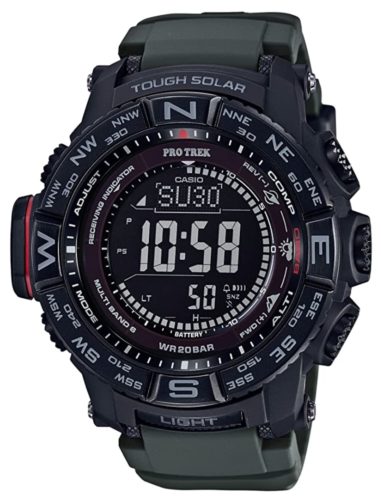
The Casio Pro Trek PRW-3510Y is one of the top watches to have for long treks in the wild. Not only does it come with atomic precision and solar-powered quartz movement, but it also features the Triple Sensor technology.
The innovation comprises a digital compass, barometer/altimeter, and thermometer. The Pro Trek can withstand severe weather conditions since it’s temperature resistant from 14F (-10C) to 140F (60C). Therefore, no matter the conditions, the watch won’t fail you.
Quality-wise, this Pro Trek doesn’t lag behind in comparison to G-Shock watches. The watch is 200m (660ft) water-resistant, is made from lightweight and durable resin, and has shock-absorbing protrusions.
The watch receives time adjustments in the USA, the UK, Germany, Japan, and China within a 500-mile radius from the transmitters. For receiving the adjustments, you have to set the correct city code. However, when outside the reach, the watch runs on quartz accuracy (+/-15 seconds per month).
Last but not least, a great addition to the watch is the STN digital display that has much better legibility compared to standard negative displays.
Pro Trek PRW-2500T
Model: PRW-2500T-7CR
Case Size: 50mm
Crystal: Mineral
Power Reserve: 5 months
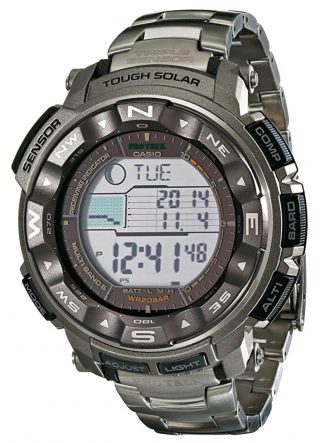
If you could put all the imaginable features into a wristwatch that an outdoorsman would need, then the Casio Pro Trek PRW-2500T is precisely the one.
For example, you can make use of the Triple Sensor, World Time, moon data, LED backlight, alarms, stopwatch, and countdown timer. All these features are backed with a solar-powered quartz movement with an approximate 5-month power reserve.
Casio’s Multiband 6 technology that covers all the major regions in the world (bar South America, Africa, and Oceania) ensures atomic precision throughout the watch’s lifetime. Like most Casio watches, you have to set the correct city code to receive nightly automatic time adjustments.
In terms of comfort, the watch isn’t the smallest around, measuring 50mm in diameter. However, when it comes to the 4 oz weight, it is a lightweight metal watch to wear. Most of the credit contributing to the light weight goes to the titanium bracelet.
All in all, the watch doesn’t cost much (around $300), offers a plethora of functions, and looks very masculine. On top of everything, it is powered by light and is always accurate.
Seiko
Although being a late bloomer in atomic wristwear, Seiko was still able to become the first brand to introduce a three-band radio wave solar watch in 2005, capable of receiving time synchronizations from Japan, Germany, and the US.
Today, Seiko offers similar coverages to those of Citizen and Casio.
Besides radio-controlled watches, Seiko has also come out with GPS-controlled watches, which are employed by the Astron collection.
Seiko Coutura Radio Sync Solar
Model: SSG009
Case Size: 44.5mm
Crystal: Sapphire
Power Reserve: 6 months

The Seiko Coutura watch is similar to Citizen’s solar atomic watches for being a casual wearable. Therefore, the Coutura watch suits various attire and occasions and is more versatile than most Casio watches.
The watch has a 6-month power reserve once fully charged. The solar quartz mechanism is also equipped with a power save function and a power reserve indicator, which offer nice opportunities to spare energy and be informed about the remaining energy levels.
The Coutura SSG009 receives nightly time adjustments and comes with a World Time feature. Therefore, it is a great watch for traveling as switching between the time zones has been made easy.
Appearance-wise, you can expect premium-level aesthetics. The watch looks way more expensive because of the sophisticated dial and well-placed blue accents. The metal bracelet adds its part with its angular shape and perfect finishing.
All things considered, the Coutura SSG009 is one of the most eye-catching and luxurious solar atomic watches. It looks stunning, has a durable build quality, and offers practical features for everyday occasions.
Seiko Astron GPS Solar
Model: SSE047
Case Size: 45mm
Crystal: Sapphire
Power Reserve: 6 months

When moving up the ladder in terms of a technological masterclass, we have the Seiko Astron GPS Solar watch. What separates it from Citizen Satellite Wave is the better build quality – a sapphire-covered face and a sturdy stainless steel case and bracelet.
The Astron watch is a pricier option for solar atomic wristwear than any other line in Casio’s or Citizen’s production. One of the reasons constituting the fact besides the better build quality is high-grade GPS technology. As a matter of fact, the first-ever GPS solar watch was precisely Seiko Astron.
The watch can discover and identify all the time zones in the world. Whenever the dial is exposed to bright light, the timepiece automatically receives GPS signals, eliminates the need to manually change the city codes.
The Astron is also equipped with a power reserve indicator, perpetual calendar, and overcharge prevention function.
When fully charged, the battery can last up to six months, or in power-save mode, up to two years.
Final Words
Convenience is the kind of merit individuals will not notice after they have it. Battery replacements and time corrections are not actually significant concerns, but if there’s a possibility to cut them off, then those who wear solar atomic watches wouldn’t swap their timepieces for anything else. The less hassle there is with a wristwatch, the more time can be allotted to activities that really matter.
Fortunately, you won’t have to pay fortunes, nor would you need to worry about the quality and reliability of the wristwear because the three Japanese brands have taken good care of it.
You may also like:
Affiliate Disclosure: As an Amazon Associate I earn from qualifying purchases. Details
- CIGA Design Blue Planet Gilding Watch: The Best Conversation Starter Around? - April 2, 2023
- CIGA Design X-Series Review: The Most Skeleton for the Money? - July 7, 2022
- What Is A Dive Watch? A Complete Guide - May 17, 2022

